To Lecture Series English Top Page
Comments on Lecture 4 "Penrose Triangle"
Comment 1. Why the Penrose triangle cannot be made using non-rectangularity trick?
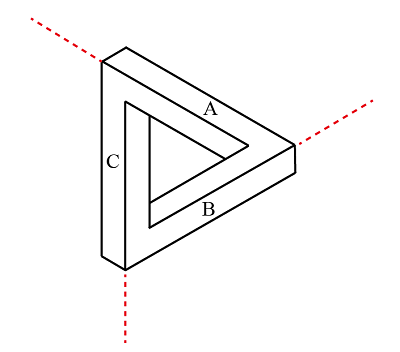 The simpler version of the Penrose triangle (the one with no crack lines) can be made using curved-surface trick but cannot be made using non-rectangularity trick. This can be understood in the following way. As shown in the left figure, the object has three visible faces A, B and C. They are three non-parallel planes in space, and hence shoud have a common point of intersection when extended. This point should be on the lines of intersections of two planes (the red broken lines), but they do not have a common point. This means that there is no 3D structure whose projectin matches the figure of the Penrose triangle.
The simpler version of the Penrose triangle (the one with no crack lines) can be made using curved-surface trick but cannot be made using non-rectangularity trick. This can be understood in the following way. As shown in the left figure, the object has three visible faces A, B and C. They are three non-parallel planes in space, and hence shoud have a common point of intersection when extended. This point should be on the lines of intersections of two planes (the red broken lines), but they do not have a common point. This means that there is no 3D structure whose projectin matches the figure of the Penrose triangle.
Comment 2. To those who want to construct the Penrose triangles by themselves
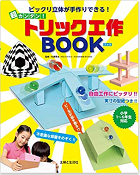
Trick Papercraft ‚a‚n‚n‚j (in Japanese, written by Kokichi Sugihara, Shufu To Seikatu Sha Publisher, Tokyo)
This book is a collection of diagrams of unfolded surfaces of impossible objects. It contains the Penrose trianlge made using the discontinuity trick.
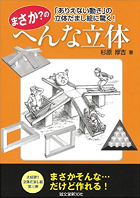
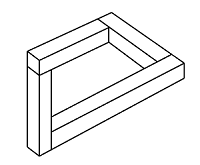
Masaka No Henna Rittai (in Japanese, written by Kokichi Sugihara, Seibundo Shinko Sha Publisher, Tokyo)
We can draw the Penrose rectangle by adding one rod to the Penrose triangle. The Penrose rectangle is also an impossible figure because the rods are connected in a twisted way. This book contains diagrams of unfolded surfaces of 20 impossible objects for paper crafting, three of which are the diagrams of the Penrose rectangles made using the discotinuity trick, the curved-surface trick and the non-rectangularity trick.
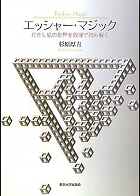 Escher Magic --- Mathematical Approaches to the World of Impossilbe Figures
(in Japanese, written by Kokichi Sugihara, The University of Tokyo Press, Tokyo)
Escher Magic --- Mathematical Approaches to the World of Impossilbe Figures
(in Japanese, written by Kokichi Sugihara, The University of Tokyo Press, Tokyo)
This book includes the method for constructing 3D objects from impossible figure using the curved-surface trick, the discontinuity trick and the non-rectangularity trick. This is not an unfolded surface diagram book. However, we can construct original impossible objects if we understand mathematics, write program and compute the diagram.
Comment 3. References for construction of impossible objects, including the Penrose triange
K. Sugihara: Three-dimentional realization of anomalous pictures---An application of picture interpretation theory to toy design. Pattern Recognition, vol. 30, no. 7 (1997), pp. 1061--1067.
K. Sugihara: A characterization of a class of anomalous solids. Interdisciplinary Information Sciences, vol. 11, no. 2 (2005), pp. 149--156.
 The simpler version of the Penrose triangle (the one with no crack lines) can be made using curved-surface trick but cannot be made using non-rectangularity trick. This can be understood in the following way. As shown in the left figure, the object has three visible faces A, B and C. They are three non-parallel planes in space, and hence shoud have a common point of intersection when extended. This point should be on the lines of intersections of two planes (the red broken lines), but they do not have a common point. This means that there is no 3D structure whose projectin matches the figure of the Penrose triangle.
The simpler version of the Penrose triangle (the one with no crack lines) can be made using curved-surface trick but cannot be made using non-rectangularity trick. This can be understood in the following way. As shown in the left figure, the object has three visible faces A, B and C. They are three non-parallel planes in space, and hence shoud have a common point of intersection when extended. This point should be on the lines of intersections of two planes (the red broken lines), but they do not have a common point. This means that there is no 3D structure whose projectin matches the figure of the Penrose triangle.



 Escher Magic --- Mathematical Approaches to the World of Impossilbe Figures
(in Japanese, written by Kokichi Sugihara, The University of Tokyo Press, Tokyo)
Escher Magic --- Mathematical Approaches to the World of Impossilbe Figures
(in Japanese, written by Kokichi Sugihara, The University of Tokyo Press, Tokyo)